Integrated Management Information System for Kool Dudes Mobile
VerifiedAdded on 2023/06/08
|13
|2840
|57
AI Summary
Kool Dudes Mobile seeks an integrated management information system to synchronize information from its branches for easier management and decision making. The proposed system should store information about device repairs, integrate marketing, manage stock, and provide reports. Budget is $9,750.00.
Contribute Materials
Your contribution can guide someone’s learning journey. Share your
documents today.
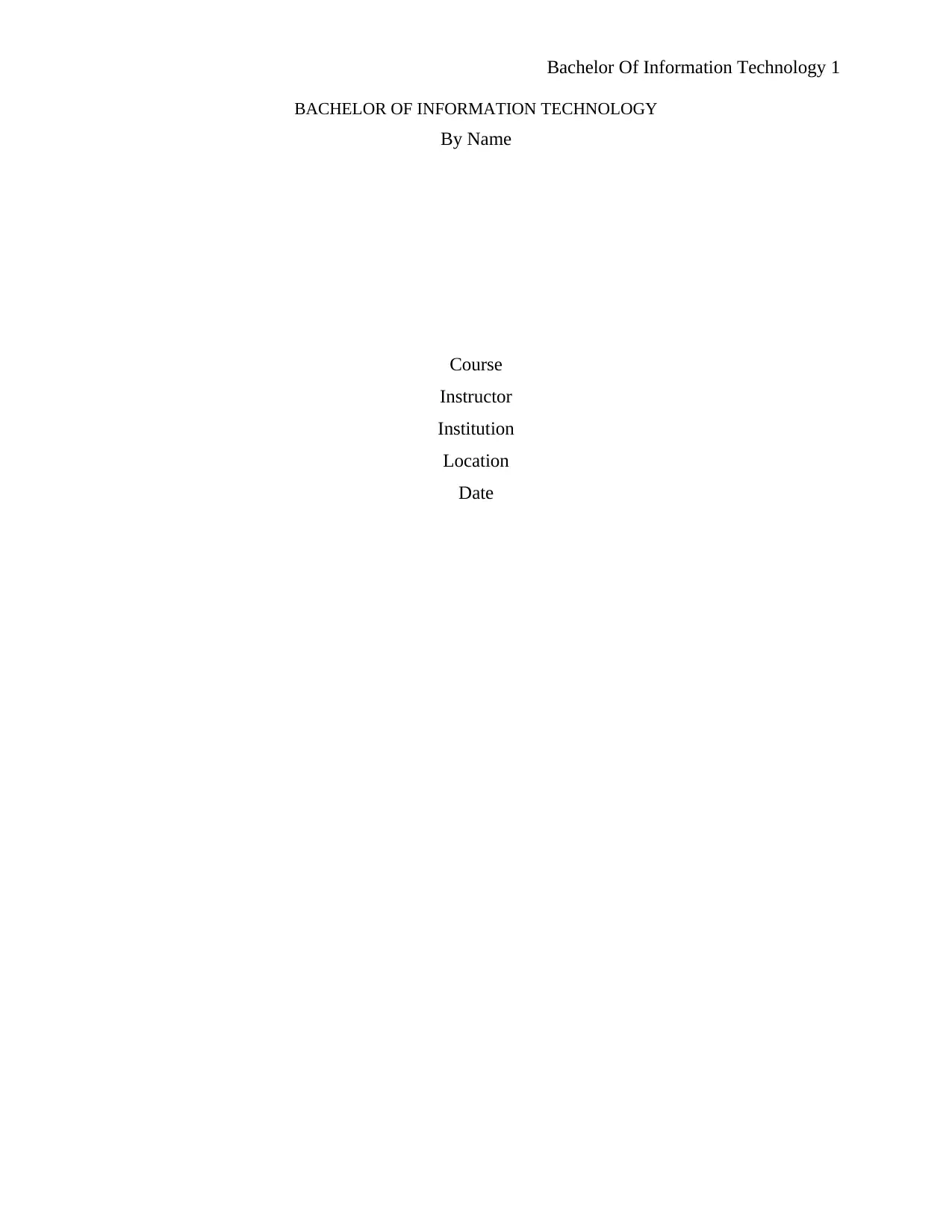
Bachelor Of Information Technology 1
BACHELOR OF INFORMATION TECHNOLOGY
By Name
Course
Instructor
Institution
Location
Date
BACHELOR OF INFORMATION TECHNOLOGY
By Name
Course
Instructor
Institution
Location
Date
Secure Best Marks with AI Grader
Need help grading? Try our AI Grader for instant feedback on your assignments.

Bachelor Of Information Technology 2
Part 1 – Testing (7 marks)
The Acceptance test (3 marks)
Introduction
The goal of this acceptance test shall be to check whether the plagiarism checker has met
all the business requirements as mentioned in the systems requirements specification and shall be
vital in the final sign off of the system and eventually going live (Tsen et al., 2012). This
document seeks to provide the procedure that shall be followed in the acceptance test. The
following requirements shall be planned in the acceptance test
Functional Requirements
1. Track student submissions
2. Detect plagiarism
3. Report plagiarism to student
4. Report plagiarism to the tutor
Nonfunctional requirements
1. Secure login
2. Optimized performance
3. Increased reliability
4. Effective and efficient
5. User-friendly
Acceptance test plan
The following aspects of the plagiarism checker shall be tested under the acceptance plan
and their failure will mean the system will not go live unless all the tests are passed (Haugset and
Hanssen, 2008). They include;
F1: Ability to detect plagiarism from a copy paste text
F2: Ability to detect translated texts from online sources
F3: Ability to detect clause quilts and or mosaics
Part 1 – Testing (7 marks)
The Acceptance test (3 marks)
Introduction
The goal of this acceptance test shall be to check whether the plagiarism checker has met
all the business requirements as mentioned in the systems requirements specification and shall be
vital in the final sign off of the system and eventually going live (Tsen et al., 2012). This
document seeks to provide the procedure that shall be followed in the acceptance test. The
following requirements shall be planned in the acceptance test
Functional Requirements
1. Track student submissions
2. Detect plagiarism
3. Report plagiarism to student
4. Report plagiarism to the tutor
Nonfunctional requirements
1. Secure login
2. Optimized performance
3. Increased reliability
4. Effective and efficient
5. User-friendly
Acceptance test plan
The following aspects of the plagiarism checker shall be tested under the acceptance plan
and their failure will mean the system will not go live unless all the tests are passed (Haugset and
Hanssen, 2008). They include;
F1: Ability to detect plagiarism from a copy paste text
F2: Ability to detect translated texts from online sources
F3: Ability to detect clause quilts and or mosaics
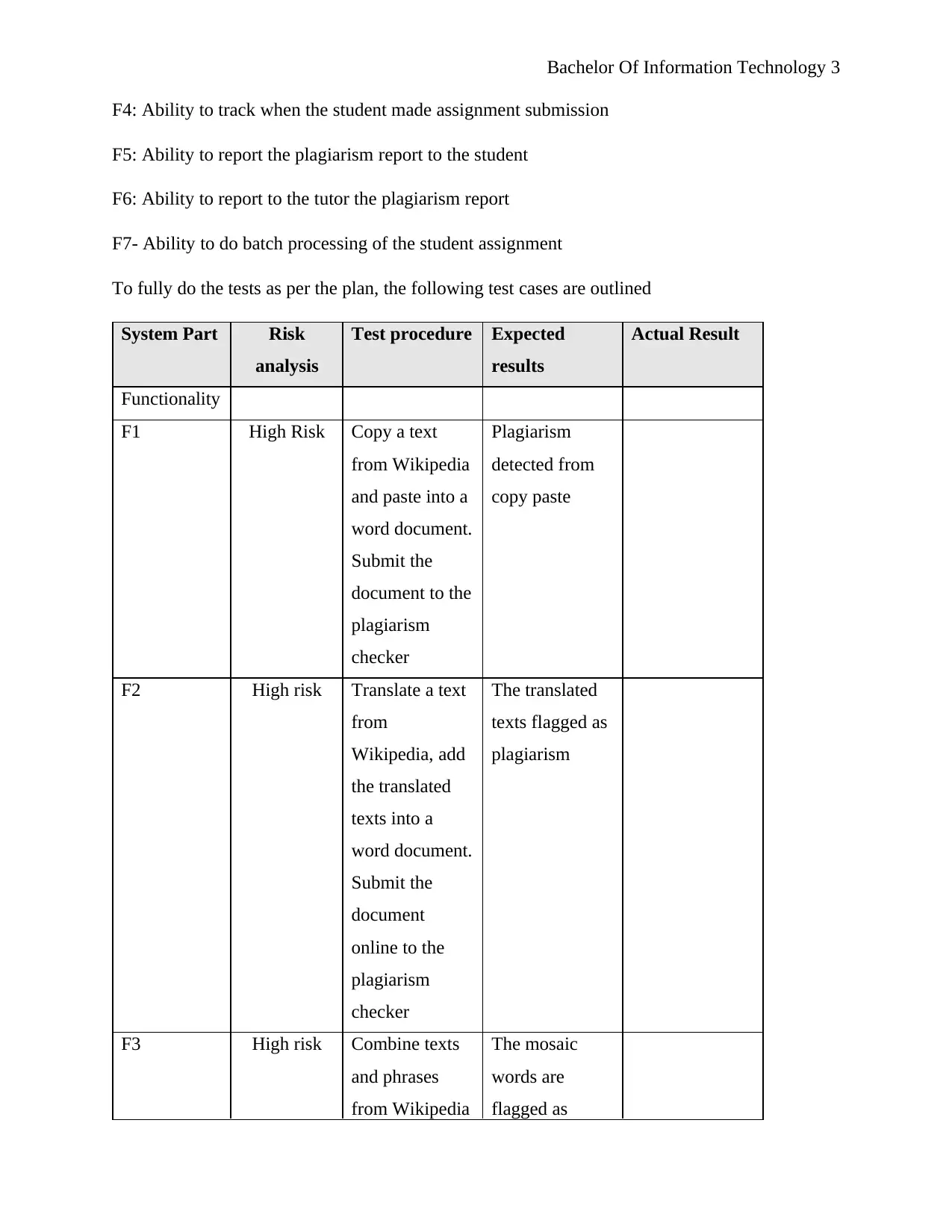
Bachelor Of Information Technology 3
F4: Ability to track when the student made assignment submission
F5: Ability to report the plagiarism report to the student
F6: Ability to report to the tutor the plagiarism report
F7- Ability to do batch processing of the student assignment
To fully do the tests as per the plan, the following test cases are outlined
System Part Risk
analysis
Test procedure Expected
results
Actual Result
Functionality
F1 High Risk Copy a text
from Wikipedia
and paste into a
word document.
Submit the
document to the
plagiarism
checker
Plagiarism
detected from
copy paste
F2 High risk Translate a text
from
Wikipedia, add
the translated
texts into a
word document.
Submit the
document
online to the
plagiarism
checker
The translated
texts flagged as
plagiarism
F3 High risk Combine texts
and phrases
from Wikipedia
The mosaic
words are
flagged as
F4: Ability to track when the student made assignment submission
F5: Ability to report the plagiarism report to the student
F6: Ability to report to the tutor the plagiarism report
F7- Ability to do batch processing of the student assignment
To fully do the tests as per the plan, the following test cases are outlined
System Part Risk
analysis
Test procedure Expected
results
Actual Result
Functionality
F1 High Risk Copy a text
from Wikipedia
and paste into a
word document.
Submit the
document to the
plagiarism
checker
Plagiarism
detected from
copy paste
F2 High risk Translate a text
from
Wikipedia, add
the translated
texts into a
word document.
Submit the
document
online to the
plagiarism
checker
The translated
texts flagged as
plagiarism
F3 High risk Combine texts
and phrases
from Wikipedia
The mosaic
words are
flagged as
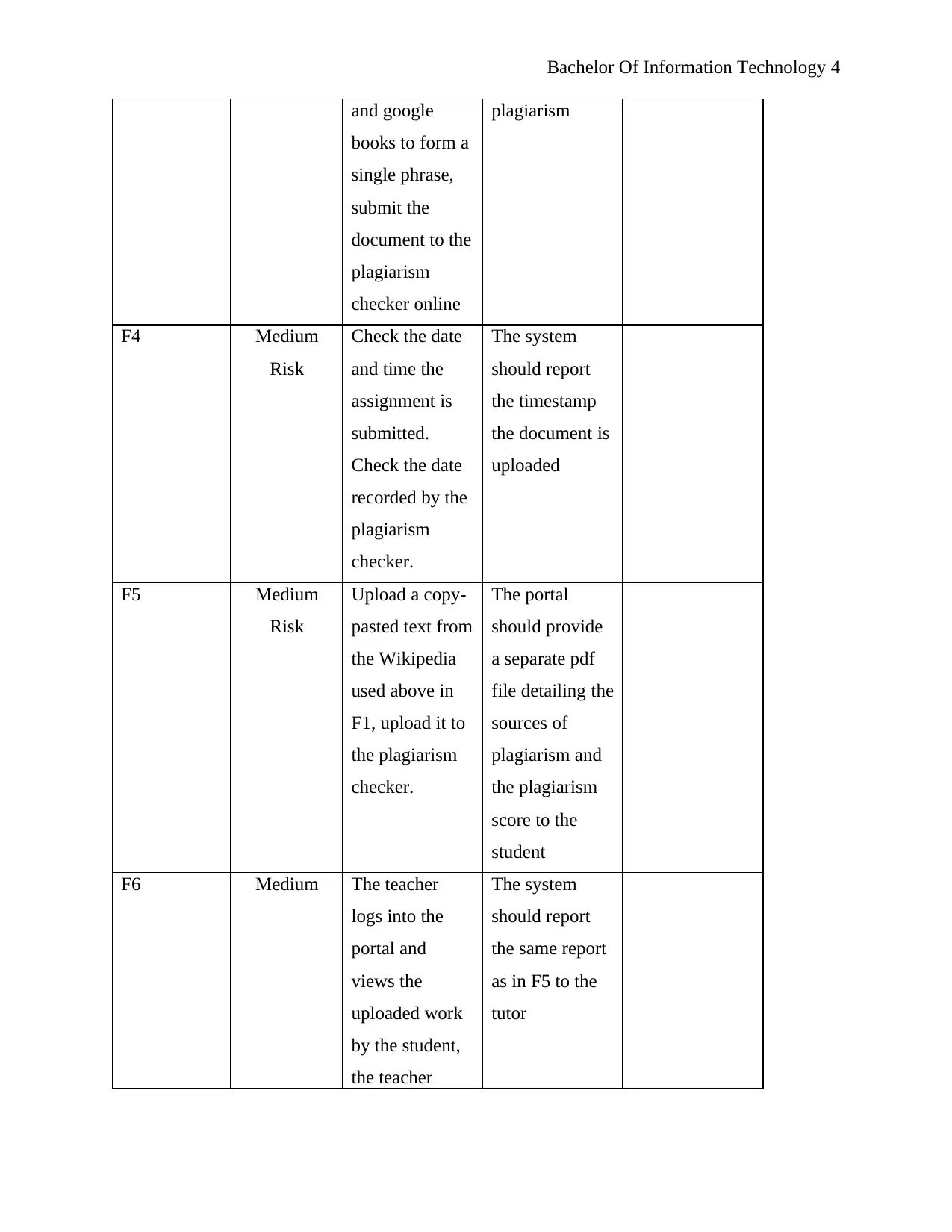
Bachelor Of Information Technology 4
and google
books to form a
single phrase,
submit the
document to the
plagiarism
checker online
plagiarism
F4 Medium
Risk
Check the date
and time the
assignment is
submitted.
Check the date
recorded by the
plagiarism
checker.
The system
should report
the timestamp
the document is
uploaded
F5 Medium
Risk
Upload a copy-
pasted text from
the Wikipedia
used above in
F1, upload it to
the plagiarism
checker.
The portal
should provide
a separate pdf
file detailing the
sources of
plagiarism and
the plagiarism
score to the
student
F6 Medium The teacher
logs into the
portal and
views the
uploaded work
by the student,
the teacher
The system
should report
the same report
as in F5 to the
tutor
and google
books to form a
single phrase,
submit the
document to the
plagiarism
checker online
plagiarism
F4 Medium
Risk
Check the date
and time the
assignment is
submitted.
Check the date
recorded by the
plagiarism
checker.
The system
should report
the timestamp
the document is
uploaded
F5 Medium
Risk
Upload a copy-
pasted text from
the Wikipedia
used above in
F1, upload it to
the plagiarism
checker.
The portal
should provide
a separate pdf
file detailing the
sources of
plagiarism and
the plagiarism
score to the
student
F6 Medium The teacher
logs into the
portal and
views the
uploaded work
by the student,
the teacher
The system
should report
the same report
as in F5 to the
tutor
Secure Best Marks with AI Grader
Need help grading? Try our AI Grader for instant feedback on your assignments.
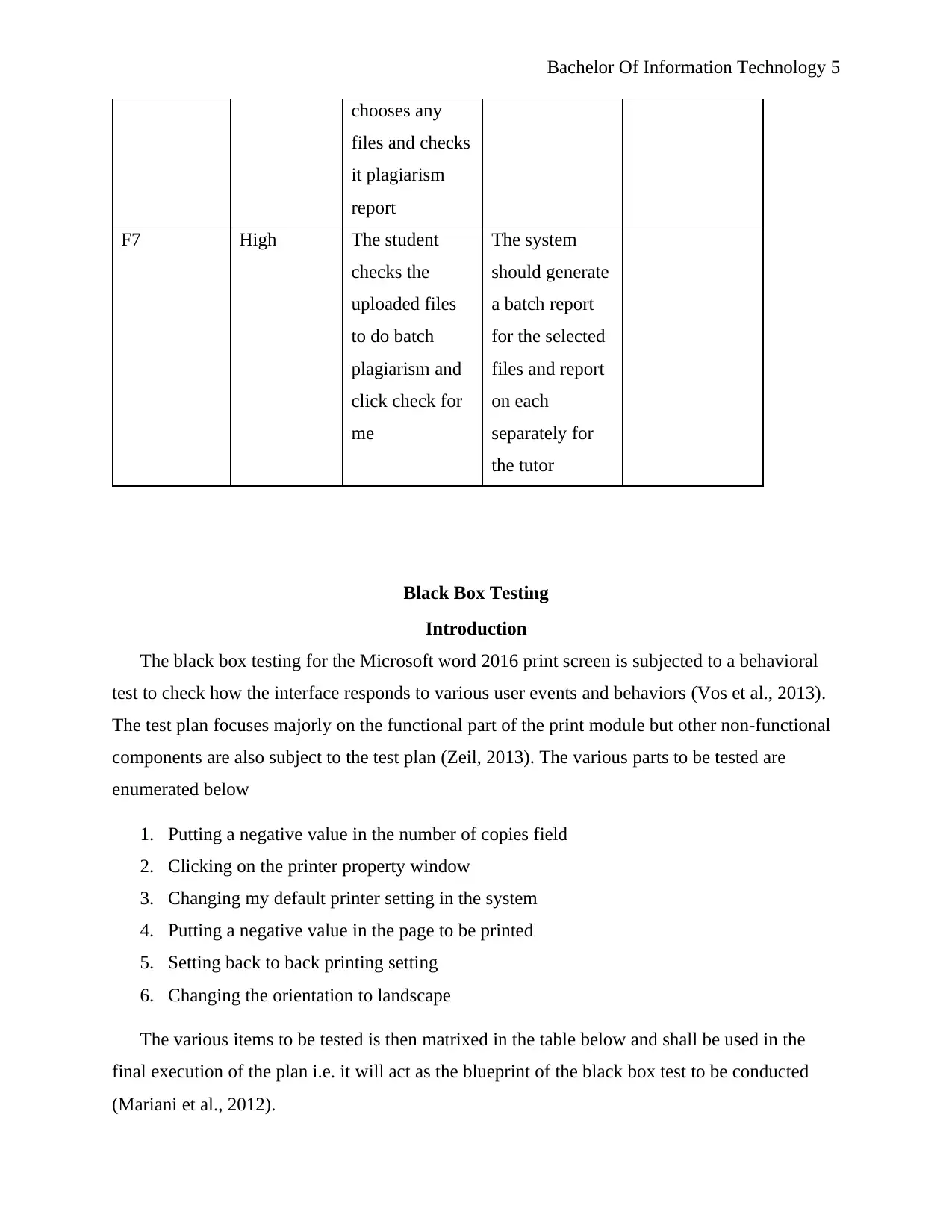
Bachelor Of Information Technology 5
chooses any
files and checks
it plagiarism
report
F7 High The student
checks the
uploaded files
to do batch
plagiarism and
click check for
me
The system
should generate
a batch report
for the selected
files and report
on each
separately for
the tutor
Black Box Testing
Introduction
The black box testing for the Microsoft word 2016 print screen is subjected to a behavioral
test to check how the interface responds to various user events and behaviors (Vos et al., 2013).
The test plan focuses majorly on the functional part of the print module but other non-functional
components are also subject to the test plan (Zeil, 2013). The various parts to be tested are
enumerated below
1. Putting a negative value in the number of copies field
2. Clicking on the printer property window
3. Changing my default printer setting in the system
4. Putting a negative value in the page to be printed
5. Setting back to back printing setting
6. Changing the orientation to landscape
The various items to be tested is then matrixed in the table below and shall be used in the
final execution of the plan i.e. it will act as the blueprint of the black box test to be conducted
(Mariani et al., 2012).
chooses any
files and checks
it plagiarism
report
F7 High The student
checks the
uploaded files
to do batch
plagiarism and
click check for
me
The system
should generate
a batch report
for the selected
files and report
on each
separately for
the tutor
Black Box Testing
Introduction
The black box testing for the Microsoft word 2016 print screen is subjected to a behavioral
test to check how the interface responds to various user events and behaviors (Vos et al., 2013).
The test plan focuses majorly on the functional part of the print module but other non-functional
components are also subject to the test plan (Zeil, 2013). The various parts to be tested are
enumerated below
1. Putting a negative value in the number of copies field
2. Clicking on the printer property window
3. Changing my default printer setting in the system
4. Putting a negative value in the page to be printed
5. Setting back to back printing setting
6. Changing the orientation to landscape
The various items to be tested is then matrixed in the table below and shall be used in the
final execution of the plan i.e. it will act as the blueprint of the black box test to be conducted
(Mariani et al., 2012).

Bachelor Of Information Technology 6
System Part Test
Description
Test data Procedure Expected
Result
Actual Result
Test Number
1 Checking
the input
bounds on
the number
of copies
text box
Integer -1 Click ctrl+p to
get to the print
form, enter -1 in
the number of
copies field,
click print
The system
should warn of
no negative
numbers
accepted
2 Clicking the
printer
property
link should
open up
another
window
with the
printer
properties of
the current
form
Not applicable Once the
document opens
in a word, click
ctrl+p to go to
the print dialog,
click on the
printer property
link
A new dialog
box with the
printer property
listed for the
current file
3 Test
whether the
module
changes
behavior
based on the
printer
selected as
default in
Not applicable Change the
printer default
in the devices
and printer of
the system,
click on another
printer, set as
default, click
save. Open the
The default
printer changes
according to the
one set
System Part Test
Description
Test data Procedure Expected
Result
Actual Result
Test Number
1 Checking
the input
bounds on
the number
of copies
text box
Integer -1 Click ctrl+p to
get to the print
form, enter -1 in
the number of
copies field,
click print
The system
should warn of
no negative
numbers
accepted
2 Clicking the
printer
property
link should
open up
another
window
with the
printer
properties of
the current
form
Not applicable Once the
document opens
in a word, click
ctrl+p to go to
the print dialog,
click on the
printer property
link
A new dialog
box with the
printer property
listed for the
current file
3 Test
whether the
module
changes
behavior
based on the
printer
selected as
default in
Not applicable Change the
printer default
in the devices
and printer of
the system,
click on another
printer, set as
default, click
save. Open the
The default
printer changes
according to the
one set
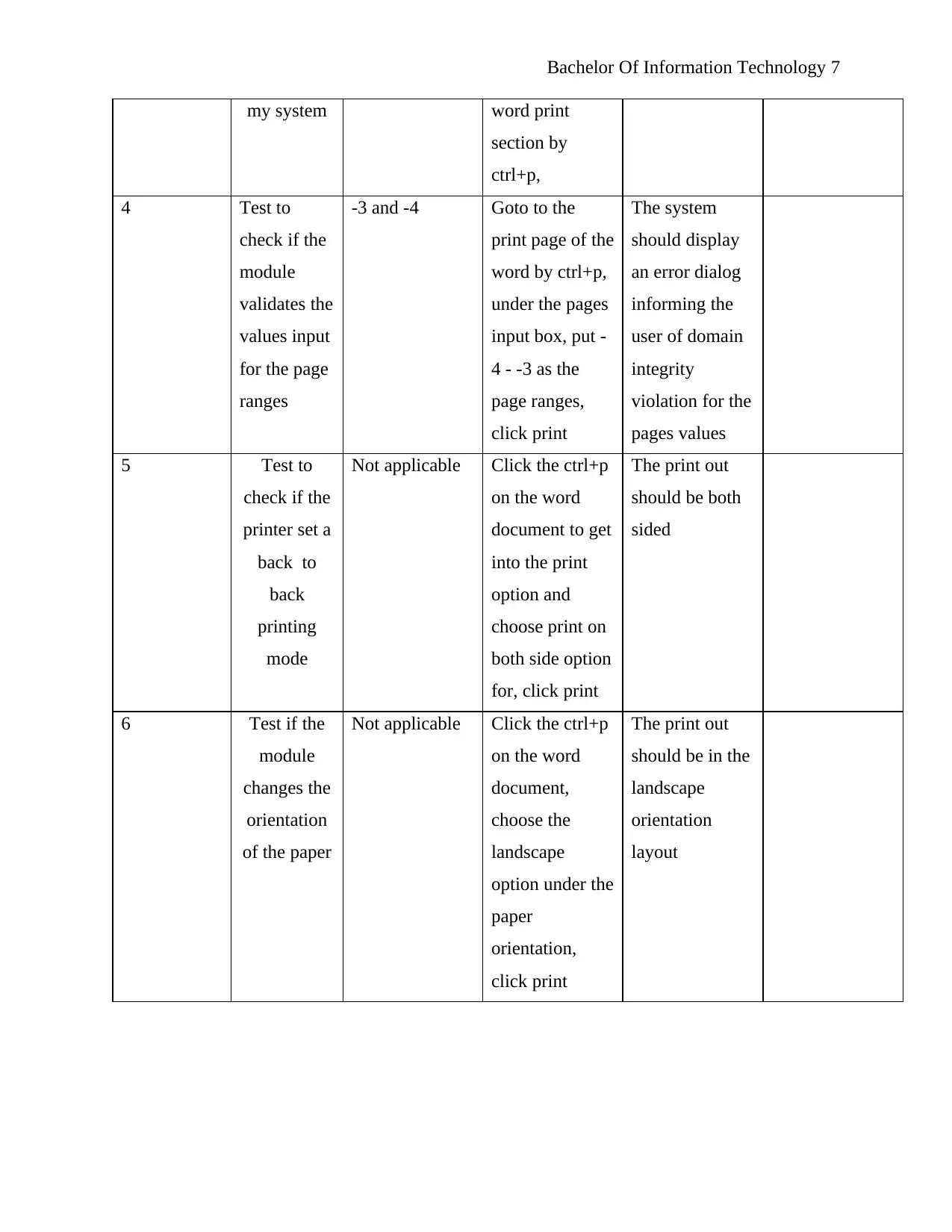
Bachelor Of Information Technology 7
my system word print
section by
ctrl+p,
4 Test to
check if the
module
validates the
values input
for the page
ranges
-3 and -4 Goto to the
print page of the
word by ctrl+p,
under the pages
input box, put -
4 - -3 as the
page ranges,
click print
The system
should display
an error dialog
informing the
user of domain
integrity
violation for the
pages values
5 Test to
check if the
printer set a
back to
back
printing
mode
Not applicable Click the ctrl+p
on the word
document to get
into the print
option and
choose print on
both side option
for, click print
The print out
should be both
sided
6 Test if the
module
changes the
orientation
of the paper
Not applicable Click the ctrl+p
on the word
document,
choose the
landscape
option under the
paper
orientation,
click print
The print out
should be in the
landscape
orientation
layout
my system word print
section by
ctrl+p,
4 Test to
check if the
module
validates the
values input
for the page
ranges
-3 and -4 Goto to the
print page of the
word by ctrl+p,
under the pages
input box, put -
4 - -3 as the
page ranges,
click print
The system
should display
an error dialog
informing the
user of domain
integrity
violation for the
pages values
5 Test to
check if the
printer set a
back to
back
printing
mode
Not applicable Click the ctrl+p
on the word
document to get
into the print
option and
choose print on
both side option
for, click print
The print out
should be both
sided
6 Test if the
module
changes the
orientation
of the paper
Not applicable Click the ctrl+p
on the word
document,
choose the
landscape
option under the
paper
orientation,
click print
The print out
should be in the
landscape
orientation
layout
Paraphrase This Document
Need a fresh take? Get an instant paraphrase of this document with our AI Paraphraser
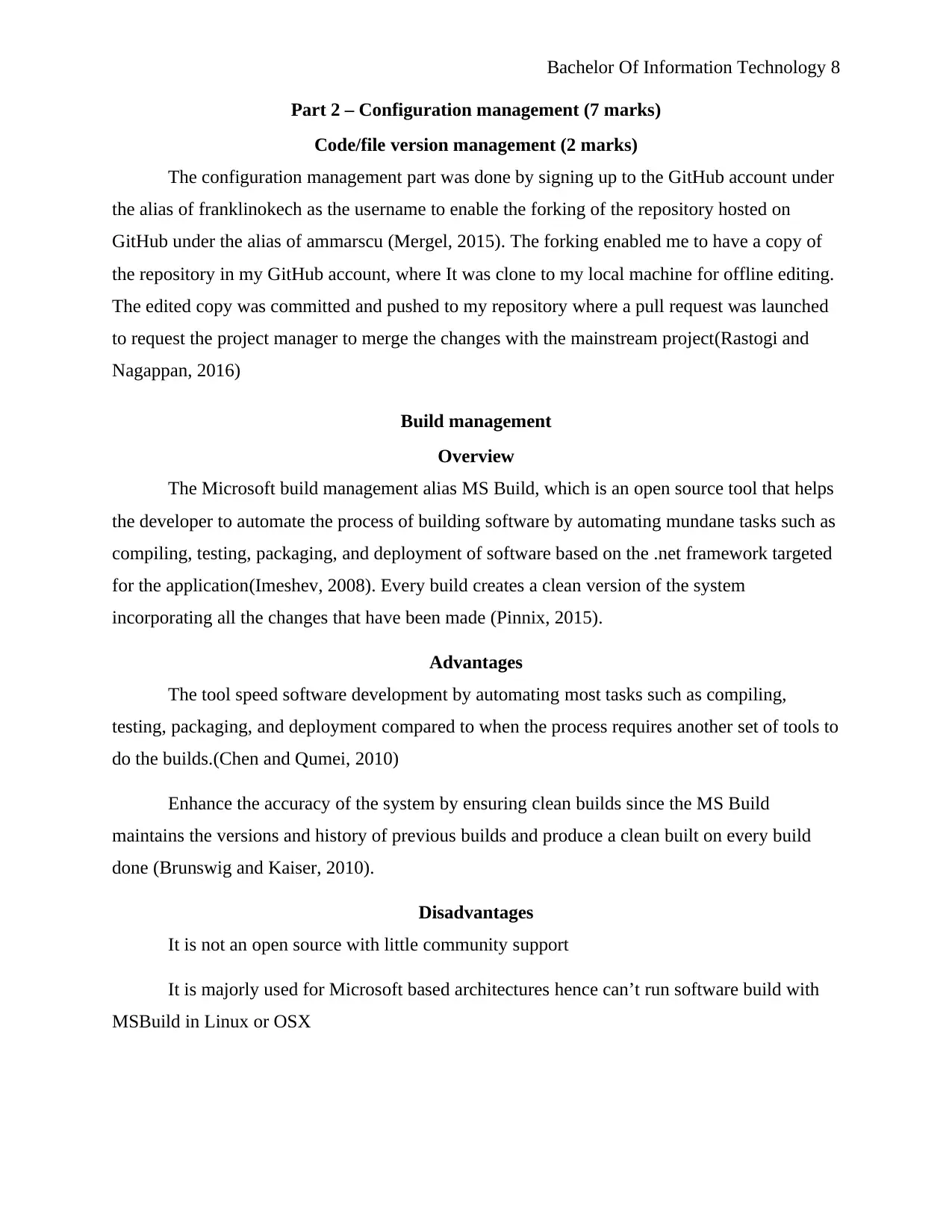
Bachelor Of Information Technology 8
Part 2 – Configuration management (7 marks)
Code/file version management (2 marks)
The configuration management part was done by signing up to the GitHub account under
the alias of franklinokech as the username to enable the forking of the repository hosted on
GitHub under the alias of ammarscu (Mergel, 2015). The forking enabled me to have a copy of
the repository in my GitHub account, where It was clone to my local machine for offline editing.
The edited copy was committed and pushed to my repository where a pull request was launched
to request the project manager to merge the changes with the mainstream project(Rastogi and
Nagappan, 2016)
Build management
Overview
The Microsoft build management alias MS Build, which is an open source tool that helps
the developer to automate the process of building software by automating mundane tasks such as
compiling, testing, packaging, and deployment of software based on the .net framework targeted
for the application(Imeshev, 2008). Every build creates a clean version of the system
incorporating all the changes that have been made (Pinnix, 2015).
Advantages
The tool speed software development by automating most tasks such as compiling,
testing, packaging, and deployment compared to when the process requires another set of tools to
do the builds.(Chen and Qumei, 2010)
Enhance the accuracy of the system by ensuring clean builds since the MS Build
maintains the versions and history of previous builds and produce a clean built on every build
done (Brunswig and Kaiser, 2010).
Disadvantages
It is not an open source with little community support
It is majorly used for Microsoft based architectures hence can’t run software build with
MSBuild in Linux or OSX
Part 2 – Configuration management (7 marks)
Code/file version management (2 marks)
The configuration management part was done by signing up to the GitHub account under
the alias of franklinokech as the username to enable the forking of the repository hosted on
GitHub under the alias of ammarscu (Mergel, 2015). The forking enabled me to have a copy of
the repository in my GitHub account, where It was clone to my local machine for offline editing.
The edited copy was committed and pushed to my repository where a pull request was launched
to request the project manager to merge the changes with the mainstream project(Rastogi and
Nagappan, 2016)
Build management
Overview
The Microsoft build management alias MS Build, which is an open source tool that helps
the developer to automate the process of building software by automating mundane tasks such as
compiling, testing, packaging, and deployment of software based on the .net framework targeted
for the application(Imeshev, 2008). Every build creates a clean version of the system
incorporating all the changes that have been made (Pinnix, 2015).
Advantages
The tool speed software development by automating most tasks such as compiling,
testing, packaging, and deployment compared to when the process requires another set of tools to
do the builds.(Chen and Qumei, 2010)
Enhance the accuracy of the system by ensuring clean builds since the MS Build
maintains the versions and history of previous builds and produce a clean built on every build
done (Brunswig and Kaiser, 2010).
Disadvantages
It is not an open source with little community support
It is majorly used for Microsoft based architectures hence can’t run software build with
MSBuild in Linux or OSX
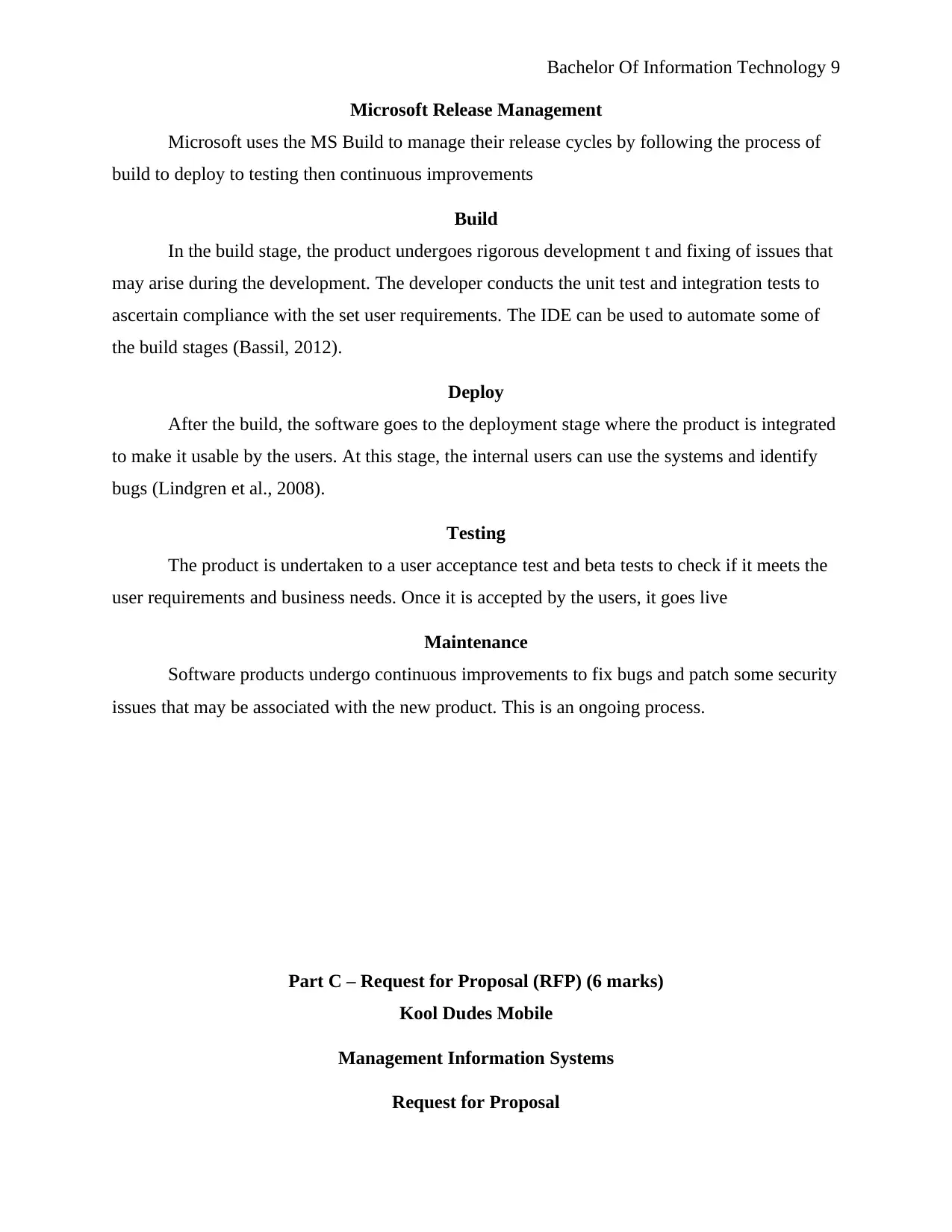
Bachelor Of Information Technology 9
Microsoft Release Management
Microsoft uses the MS Build to manage their release cycles by following the process of
build to deploy to testing then continuous improvements
Build
In the build stage, the product undergoes rigorous development t and fixing of issues that
may arise during the development. The developer conducts the unit test and integration tests to
ascertain compliance with the set user requirements. The IDE can be used to automate some of
the build stages (Bassil, 2012).
Deploy
After the build, the software goes to the deployment stage where the product is integrated
to make it usable by the users. At this stage, the internal users can use the systems and identify
bugs (Lindgren et al., 2008).
Testing
The product is undertaken to a user acceptance test and beta tests to check if it meets the
user requirements and business needs. Once it is accepted by the users, it goes live
Maintenance
Software products undergo continuous improvements to fix bugs and patch some security
issues that may be associated with the new product. This is an ongoing process.
Part C – Request for Proposal (RFP) (6 marks)
Kool Dudes Mobile
Management Information Systems
Request for Proposal
Microsoft Release Management
Microsoft uses the MS Build to manage their release cycles by following the process of
build to deploy to testing then continuous improvements
Build
In the build stage, the product undergoes rigorous development t and fixing of issues that
may arise during the development. The developer conducts the unit test and integration tests to
ascertain compliance with the set user requirements. The IDE can be used to automate some of
the build stages (Bassil, 2012).
Deploy
After the build, the software goes to the deployment stage where the product is integrated
to make it usable by the users. At this stage, the internal users can use the systems and identify
bugs (Lindgren et al., 2008).
Testing
The product is undertaken to a user acceptance test and beta tests to check if it meets the
user requirements and business needs. Once it is accepted by the users, it goes live
Maintenance
Software products undergo continuous improvements to fix bugs and patch some security
issues that may be associated with the new product. This is an ongoing process.
Part C – Request for Proposal (RFP) (6 marks)
Kool Dudes Mobile
Management Information Systems
Request for Proposal
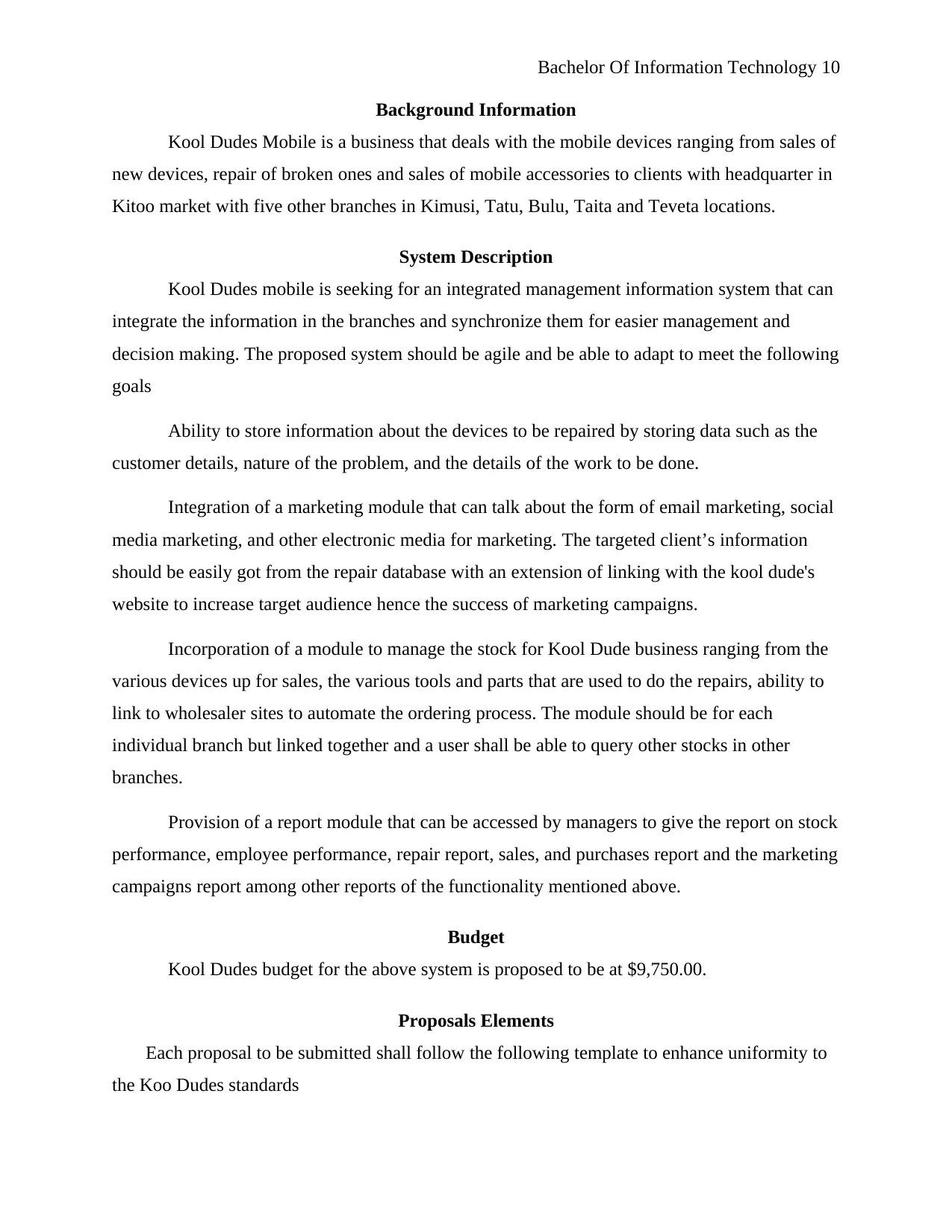
Bachelor Of Information Technology 10
Background Information
Kool Dudes Mobile is a business that deals with the mobile devices ranging from sales of
new devices, repair of broken ones and sales of mobile accessories to clients with headquarter in
Kitoo market with five other branches in Kimusi, Tatu, Bulu, Taita and Teveta locations.
System Description
Kool Dudes mobile is seeking for an integrated management information system that can
integrate the information in the branches and synchronize them for easier management and
decision making. The proposed system should be agile and be able to adapt to meet the following
goals
Ability to store information about the devices to be repaired by storing data such as the
customer details, nature of the problem, and the details of the work to be done.
Integration of a marketing module that can talk about the form of email marketing, social
media marketing, and other electronic media for marketing. The targeted client’s information
should be easily got from the repair database with an extension of linking with the kool dude's
website to increase target audience hence the success of marketing campaigns.
Incorporation of a module to manage the stock for Kool Dude business ranging from the
various devices up for sales, the various tools and parts that are used to do the repairs, ability to
link to wholesaler sites to automate the ordering process. The module should be for each
individual branch but linked together and a user shall be able to query other stocks in other
branches.
Provision of a report module that can be accessed by managers to give the report on stock
performance, employee performance, repair report, sales, and purchases report and the marketing
campaigns report among other reports of the functionality mentioned above.
Budget
Kool Dudes budget for the above system is proposed to be at $9,750.00.
Proposals Elements
Each proposal to be submitted shall follow the following template to enhance uniformity to
the Koo Dudes standards
Background Information
Kool Dudes Mobile is a business that deals with the mobile devices ranging from sales of
new devices, repair of broken ones and sales of mobile accessories to clients with headquarter in
Kitoo market with five other branches in Kimusi, Tatu, Bulu, Taita and Teveta locations.
System Description
Kool Dudes mobile is seeking for an integrated management information system that can
integrate the information in the branches and synchronize them for easier management and
decision making. The proposed system should be agile and be able to adapt to meet the following
goals
Ability to store information about the devices to be repaired by storing data such as the
customer details, nature of the problem, and the details of the work to be done.
Integration of a marketing module that can talk about the form of email marketing, social
media marketing, and other electronic media for marketing. The targeted client’s information
should be easily got from the repair database with an extension of linking with the kool dude's
website to increase target audience hence the success of marketing campaigns.
Incorporation of a module to manage the stock for Kool Dude business ranging from the
various devices up for sales, the various tools and parts that are used to do the repairs, ability to
link to wholesaler sites to automate the ordering process. The module should be for each
individual branch but linked together and a user shall be able to query other stocks in other
branches.
Provision of a report module that can be accessed by managers to give the report on stock
performance, employee performance, repair report, sales, and purchases report and the marketing
campaigns report among other reports of the functionality mentioned above.
Budget
Kool Dudes budget for the above system is proposed to be at $9,750.00.
Proposals Elements
Each proposal to be submitted shall follow the following template to enhance uniformity to
the Koo Dudes standards
Secure Best Marks with AI Grader
Need help grading? Try our AI Grader for instant feedback on your assignments.
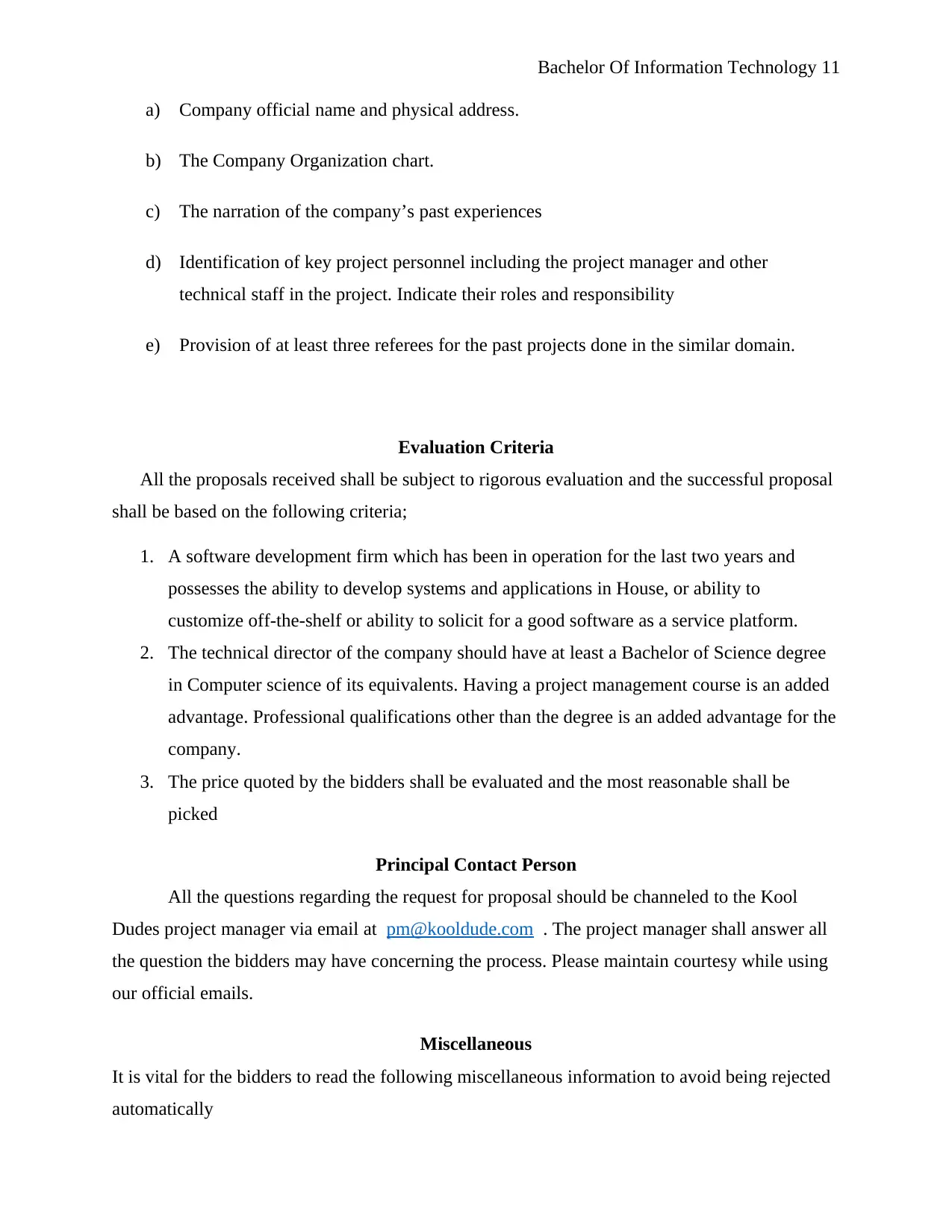
Bachelor Of Information Technology 11
a) Company official name and physical address.
b) The Company Organization chart.
c) The narration of the company’s past experiences
d) Identification of key project personnel including the project manager and other
technical staff in the project. Indicate their roles and responsibility
e) Provision of at least three referees for the past projects done in the similar domain.
Evaluation Criteria
All the proposals received shall be subject to rigorous evaluation and the successful proposal
shall be based on the following criteria;
1. A software development firm which has been in operation for the last two years and
possesses the ability to develop systems and applications in House, or ability to
customize off-the-shelf or ability to solicit for a good software as a service platform.
2. The technical director of the company should have at least a Bachelor of Science degree
in Computer science of its equivalents. Having a project management course is an added
advantage. Professional qualifications other than the degree is an added advantage for the
company.
3. The price quoted by the bidders shall be evaluated and the most reasonable shall be
picked
Principal Contact Person
All the questions regarding the request for proposal should be channeled to the Kool
Dudes project manager via email at pm@kooldude.com . The project manager shall answer all
the question the bidders may have concerning the process. Please maintain courtesy while using
our official emails.
Miscellaneous
It is vital for the bidders to read the following miscellaneous information to avoid being rejected
automatically
a) Company official name and physical address.
b) The Company Organization chart.
c) The narration of the company’s past experiences
d) Identification of key project personnel including the project manager and other
technical staff in the project. Indicate their roles and responsibility
e) Provision of at least three referees for the past projects done in the similar domain.
Evaluation Criteria
All the proposals received shall be subject to rigorous evaluation and the successful proposal
shall be based on the following criteria;
1. A software development firm which has been in operation for the last two years and
possesses the ability to develop systems and applications in House, or ability to
customize off-the-shelf or ability to solicit for a good software as a service platform.
2. The technical director of the company should have at least a Bachelor of Science degree
in Computer science of its equivalents. Having a project management course is an added
advantage. Professional qualifications other than the degree is an added advantage for the
company.
3. The price quoted by the bidders shall be evaluated and the most reasonable shall be
picked
Principal Contact Person
All the questions regarding the request for proposal should be channeled to the Kool
Dudes project manager via email at pm@kooldude.com . The project manager shall answer all
the question the bidders may have concerning the process. Please maintain courtesy while using
our official emails.
Miscellaneous
It is vital for the bidders to read the following miscellaneous information to avoid being rejected
automatically
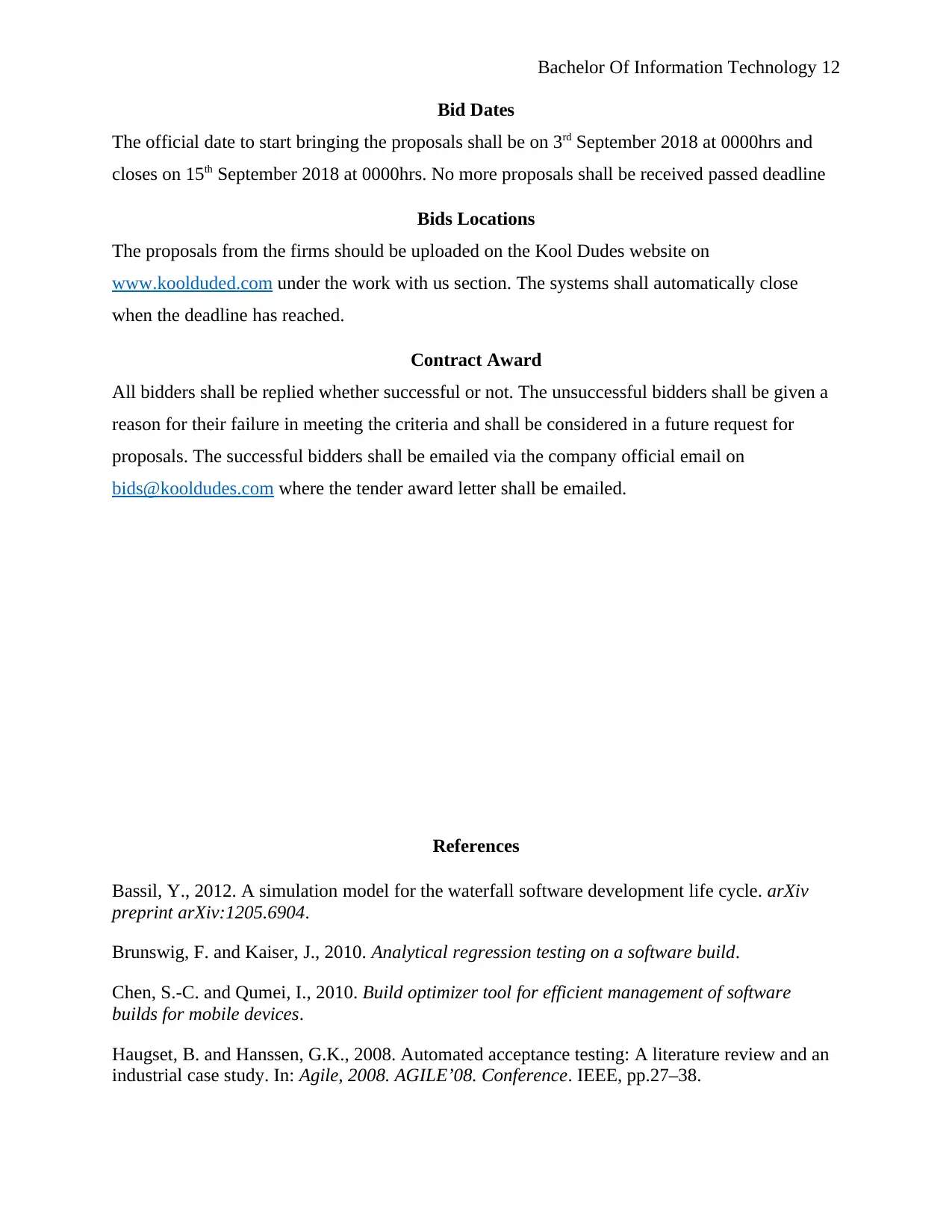
Bachelor Of Information Technology 12
Bid Dates
The official date to start bringing the proposals shall be on 3rd September 2018 at 0000hrs and
closes on 15th September 2018 at 0000hrs. No more proposals shall be received passed deadline
Bids Locations
The proposals from the firms should be uploaded on the Kool Dudes website on
www.koolduded.com under the work with us section. The systems shall automatically close
when the deadline has reached.
Contract Award
All bidders shall be replied whether successful or not. The unsuccessful bidders shall be given a
reason for their failure in meeting the criteria and shall be considered in a future request for
proposals. The successful bidders shall be emailed via the company official email on
bids@kooldudes.com where the tender award letter shall be emailed.
References
Bassil, Y., 2012. A simulation model for the waterfall software development life cycle. arXiv
preprint arXiv:1205.6904.
Brunswig, F. and Kaiser, J., 2010. Analytical regression testing on a software build.
Chen, S.-C. and Qumei, I., 2010. Build optimizer tool for efficient management of software
builds for mobile devices.
Haugset, B. and Hanssen, G.K., 2008. Automated acceptance testing: A literature review and an
industrial case study. In: Agile, 2008. AGILE’08. Conference. IEEE, pp.27–38.
Bid Dates
The official date to start bringing the proposals shall be on 3rd September 2018 at 0000hrs and
closes on 15th September 2018 at 0000hrs. No more proposals shall be received passed deadline
Bids Locations
The proposals from the firms should be uploaded on the Kool Dudes website on
www.koolduded.com under the work with us section. The systems shall automatically close
when the deadline has reached.
Contract Award
All bidders shall be replied whether successful or not. The unsuccessful bidders shall be given a
reason for their failure in meeting the criteria and shall be considered in a future request for
proposals. The successful bidders shall be emailed via the company official email on
bids@kooldudes.com where the tender award letter shall be emailed.
References
Bassil, Y., 2012. A simulation model for the waterfall software development life cycle. arXiv
preprint arXiv:1205.6904.
Brunswig, F. and Kaiser, J., 2010. Analytical regression testing on a software build.
Chen, S.-C. and Qumei, I., 2010. Build optimizer tool for efficient management of software
builds for mobile devices.
Haugset, B. and Hanssen, G.K., 2008. Automated acceptance testing: A literature review and an
industrial case study. In: Agile, 2008. AGILE’08. Conference. IEEE, pp.27–38.
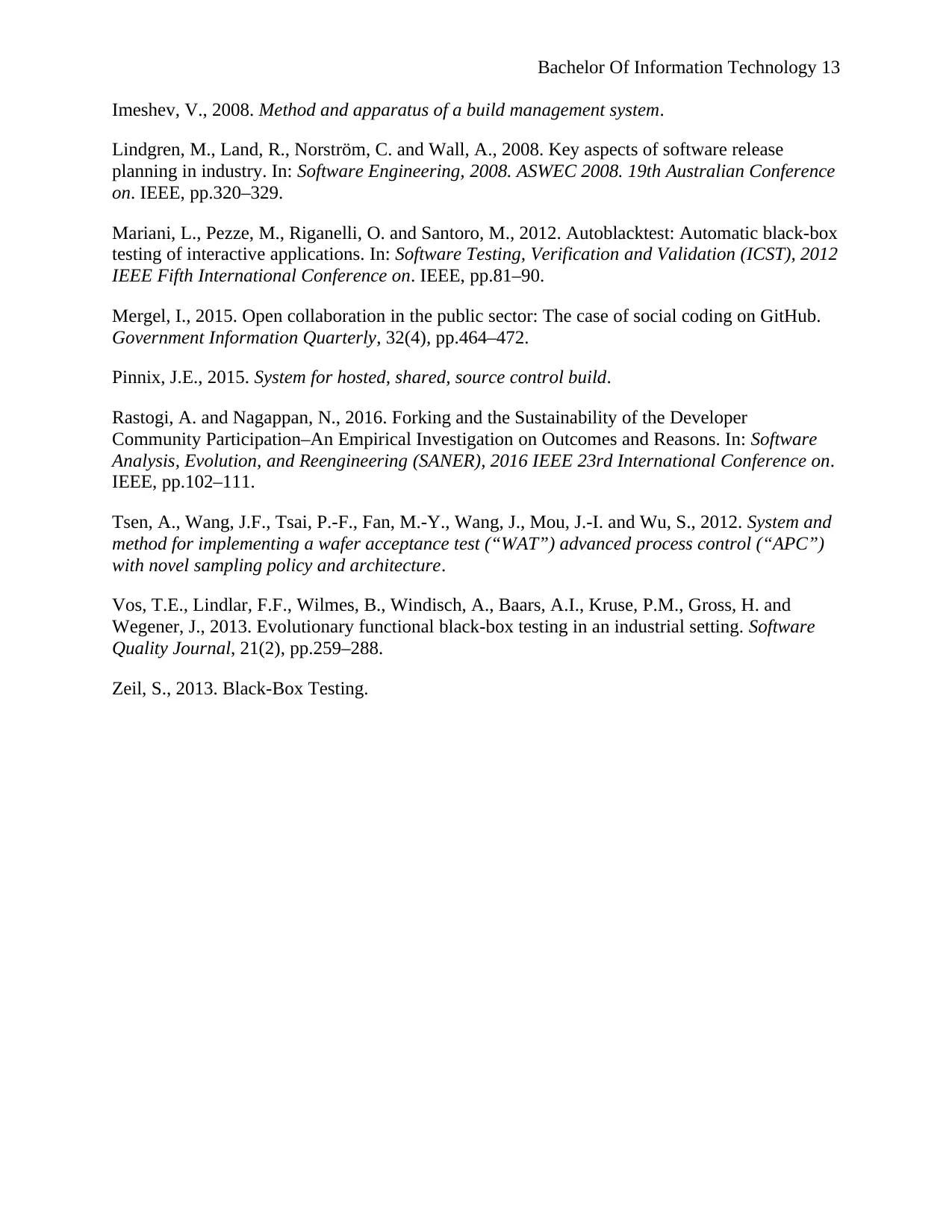
Bachelor Of Information Technology 13
Imeshev, V., 2008. Method and apparatus of a build management system.
Lindgren, M., Land, R., Norström, C. and Wall, A., 2008. Key aspects of software release
planning in industry. In: Software Engineering, 2008. ASWEC 2008. 19th Australian Conference
on. IEEE, pp.320–329.
Mariani, L., Pezze, M., Riganelli, O. and Santoro, M., 2012. Autoblacktest: Automatic black-box
testing of interactive applications. In: Software Testing, Verification and Validation (ICST), 2012
IEEE Fifth International Conference on. IEEE, pp.81–90.
Mergel, I., 2015. Open collaboration in the public sector: The case of social coding on GitHub.
Government Information Quarterly, 32(4), pp.464–472.
Pinnix, J.E., 2015. System for hosted, shared, source control build.
Rastogi, A. and Nagappan, N., 2016. Forking and the Sustainability of the Developer
Community Participation–An Empirical Investigation on Outcomes and Reasons. In: Software
Analysis, Evolution, and Reengineering (SANER), 2016 IEEE 23rd International Conference on.
IEEE, pp.102–111.
Tsen, A., Wang, J.F., Tsai, P.-F., Fan, M.-Y., Wang, J., Mou, J.-I. and Wu, S., 2012. System and
method for implementing a wafer acceptance test (“WAT”) advanced process control (“APC”)
with novel sampling policy and architecture.
Vos, T.E., Lindlar, F.F., Wilmes, B., Windisch, A., Baars, A.I., Kruse, P.M., Gross, H. and
Wegener, J., 2013. Evolutionary functional black-box testing in an industrial setting. Software
Quality Journal, 21(2), pp.259–288.
Zeil, S., 2013. Black-Box Testing.
Imeshev, V., 2008. Method and apparatus of a build management system.
Lindgren, M., Land, R., Norström, C. and Wall, A., 2008. Key aspects of software release
planning in industry. In: Software Engineering, 2008. ASWEC 2008. 19th Australian Conference
on. IEEE, pp.320–329.
Mariani, L., Pezze, M., Riganelli, O. and Santoro, M., 2012. Autoblacktest: Automatic black-box
testing of interactive applications. In: Software Testing, Verification and Validation (ICST), 2012
IEEE Fifth International Conference on. IEEE, pp.81–90.
Mergel, I., 2015. Open collaboration in the public sector: The case of social coding on GitHub.
Government Information Quarterly, 32(4), pp.464–472.
Pinnix, J.E., 2015. System for hosted, shared, source control build.
Rastogi, A. and Nagappan, N., 2016. Forking and the Sustainability of the Developer
Community Participation–An Empirical Investigation on Outcomes and Reasons. In: Software
Analysis, Evolution, and Reengineering (SANER), 2016 IEEE 23rd International Conference on.
IEEE, pp.102–111.
Tsen, A., Wang, J.F., Tsai, P.-F., Fan, M.-Y., Wang, J., Mou, J.-I. and Wu, S., 2012. System and
method for implementing a wafer acceptance test (“WAT”) advanced process control (“APC”)
with novel sampling policy and architecture.
Vos, T.E., Lindlar, F.F., Wilmes, B., Windisch, A., Baars, A.I., Kruse, P.M., Gross, H. and
Wegener, J., 2013. Evolutionary functional black-box testing in an industrial setting. Software
Quality Journal, 21(2), pp.259–288.
Zeil, S., 2013. Black-Box Testing.
1 out of 13
Your All-in-One AI-Powered Toolkit for Academic Success.
+13062052269
info@desklib.com
Available 24*7 on WhatsApp / Email
![[object Object]](/_next/static/media/star-bottom.7253800d.svg)
Unlock your academic potential
© 2024 | Zucol Services PVT LTD | All rights reserved.